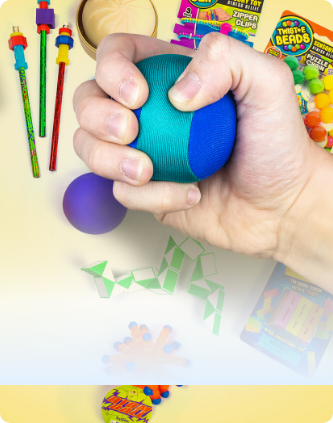Beyond the “Silly”! Ideas and Examples Of How To Teach Your Child The Real Meanings Of Idioms!
Posted by Don D’Amore M.A., CCC-SLP Speech Language Pathologist on Jan 25th 2024

By: Don D’Amore M.A., CCC-SLP Speech Language Pathologist
Do you know a child who hears an idiom phrases such as “That’s a piece of cake” and they start to ask you: “Where is the cake?” Or maybe they are wondering how a person could possibly fit in a jar when they hear someone say the idiom: “She’s in a pickle”. If they are asking about it, that is usually a good thing! Asking about things means your child wants to learn more! Let’s talk about fun ways to teach the real meanings of idioms to your child by linking silly idioms to their literal answers using pictures!
Idiom phrases can sometimes be confusing that they might be difficult for any of us to wrap our brain around! Imagine what it might feel like if you put yourself in the shoes of a child (or someone else who’s starting from scratch to learn our language). Idioms don’t come up just once in a blue moon. In fact idioms are here, there, and everywhere! Sometimes idioms are right under our nose, and we don’t even notice! Don’t get all bent out of shape if you are missing the boat, and you can’t always notice when people are using idioms. While idioms are a dime a dozen, it is not always a piece of cake to spot them! However if you keep an eye out for idioms, you may start to notice they are in almost everyone’s everyday conversations! (By the way: there were at least 11 idioms in this paragraph! Did you catch them all?)
UNDERSTANDING IDIOMS:
Idioms are a type of expression or phrase that has a figurative meaning that is not the same as the words that are being used. Usually they do not sound anything like their true meaning. That makes them confusing! Especially when your child is already trying to learn what all the other new words in their life mean. The words someone says to them are usually understood to mean exactly what they heard. For example, if someone says to your child: “I feel sick,” most children know they are telling them that they do not feel well. But an idiom is different. An idiom does not mean exactly what the words sound like they might mean. For example if someone said the idiom: “I am feeling under the weather,” a child (who is not familiar with that idiom) would have a hard time figuring out what the “under the weather” phrase means. Instead of realizing that the person was meaning to say that they are “feeling sick,” a child (or anyone who does not know that “under the weather” idiom) might think the person is really telling them they are feeling “…like they are literally under the ‘rain’ or ‘snow’ or maybe ‘a weather chart’” even!
Imagine if you saw a basic math problem where the numbers did not add up to the actual answer (such as 2 + 2 = 5). This is sort of how an idiom may sound to a child. Your child hears the words of the idiom, and they think they know what those words really mean, but the idiom expression can represent a totally different idea entirely! It is natural that there would be some confusion when it comes to idioms.
Idioms can disrupt attention. Whenever someone uses an idiom that is new to you, it may interrupt your listening experience. Suddenly instead of paying attention to whatever else they are saying, you could become distracted as you try to figure out the meaning of the strange new idiom phrase they just used. Or you might misinterpret their idiom phrase, and you could think of a totally different thing from what they intended. The same experiences can happen with a child who hears people using idioms that they do not know yet. Instead of paying close attention to what a person is saying, they may now be thinking about the “silly idea” of the new idiom they just heard.
So if they can be so confusing, why do people even use idioms? There are several possible reasons: Some idioms have been used for generations, and so they are passed down just like all the language that we speak has been passed on to us by all of the people who used the language before us. Idioms are such a common part of our language that many people might not even realize they are using them!
Idioms can serve an important purpose in our language. Sometimes people like to use an idiom to make what they are saying sound a little more interesting or colorful. A person might feel an idiom helps them to emphasize or further explain what they were trying to say even better than the literal words themselves in certain situations.
Whatever the reason, idioms are always going to be a part of the way people communicate, so learning the meaning behind common idioms may help your child to better understand what people are trying to say when they hear that idiom used later by someone else. Your child may also start to learn when they could use an idiom themselves while talking to people. Practicing new idioms with your child can be a fun way to expand their knowledge and broaden their overall language skills!
So how can I teach my child to learn Idioms? Try to use visuals to “Show what the idiom
words mean”!
Understanding the actual words of an idiom may be tricky. Spoken words alone can seem abstract to many children, but using visual pictures allow those confusing new words they hear to look like something real! To quote one famous idiom: “A picture is worth a 1000 words!” This can also be true with helping to learn idioms! If hearing the words by themselves are difficult for your child, seeing matching pictures may help to give them much more information and assist them to better understand the meanings. When there is a picture to look at, a child can now see it and not just hear it! This can be especially powerful if your child is stronger at understanding with visual learning supports for other learning areas.
Try to also show illustrations of the idiom’s real “meanings” as well!
I like to recommend that when teaching about idioms, try focusing on teaching the idioms literal meanings! Giving the child a visual image of the actual literal answer to what that confusing idiom phrase really means may be able to help the child to finally see what they could not visualize on their own!
While matching illustrations that represent the idiom words can be fun, the idiom picture alone may be just as confusing to a child as the words themselves were! In some ways it could lead to the child still misunderstanding the idiom’s true meaning. If the child only saw the illustration of the silly idiom, and that is what they already thought it meant, how do they move past that silly idea to understand the true literal meaning of the idiom? A picture of a “person inside of an actual pickle” is funny, but it does not really help to explain what that idiom really means. To teach the real meaning of those silly idioms, try to match each idiom with an additional picture which illustrates the real meaning of the idiom! This way the child can use the addition of these visual representations to strengthen their overall learning experience of the meanings beyond the (often confusing idiom) words that they hear! Now the last image that the child is looking at is actually explaining the meaning of the funny idiom!
Preparation:
Start by gathering lots of illustrations! You should try to find illustrations of both the idioms as well as illustrations of their meanings so you can pair them together as you teach. Here is a list of some common idioms and their meanings to get you started:
IDIOM: I’m in a pickle. MEANING: I have to make a difficult decision.
IDIOM: We’re not out of the woods yet. MEANING: We still have some problems.
IDIOM: He is all thumbs. MEANING: He is very clumsy at doing things.
IDIOM: He’s finally off the hook. MEANING: He’s no longer responsible or being blamed.
IDIOM: Hold your horses. MEANING: Wait or slow down.
IDIOM: She has butterflies in my stomach. MEANING: She feels nervous.
IDIOM: This is a real can of worms. MEANING: This is really complicated.
IDIOM: Let’s get the ball rolling. MEANING: Let’s get started.
After you have gathered your illustrations, you could start by saying something like this to your child:
“You know how sometimes people say silly things like “I am in a pickle” or “That was a piece of cake”? Those sort of silly words that meaning something else are called “Idioms”. Idioms are phrases or words that do not mean exactly what they sound like. Instead idioms usually mean something else! They can sound fun and funny! There are many different idioms. Pretty much everyone uses idioms as another way of telling us something. We are going to have some fun practicing and learning idioms!
Here is an example: If a person has a tough decision to make and they do not
know what to do, they might say the idiom: ‘I am in a pickle.’ Now we know that person
is not really inside of a real pickle, like the pickle we take out of a jar. That would be
really silly. ‘I am in a pickle’ is an idiom phrase that people sometimes use when they are
trying to say they ‘have to make a difficult decision’. Many idioms sound funny just like
the ‘I am in a pickle’ idiom. Here is another example: When someone wants to tell you
that something is simple to do, they might say “That is a piece of cake” There is no real
cake around, but the idiom “That is a piece of cake” just means something is easy or
simple to do.”
When you have illustrations ready you may say to your child:
“These materials we use today will each be a pair of pictures. We will see both a picture of the fun idiom as well as another picture of what they really mean! We can look at these pictures and talk about the idiom and also we see a picture that shows what each one means. So let’s have fun learning about idioms and their meaning!”
Then proceed one at a time to talk about the idiom phrase and idiom picture and what it sounds like. Next talk about what it could really mean, and show the picture of the literal meaning as well. Try to have fun with it! Idioms are fun and funny! Having fun is a good motivator for you child to want to continue to learn things like this. Remember this theme: “Let’s have fun and enjoy our time together as we learn new things!”
Other general ideas for helping your child with learning Idioms and their meanings:
- It is OK to have differences in the meanings for an idiom. Language is filled with varieties! Language is always changing and growing! What we think an idiom means right now may actually gradually change over time.
- Idioms are just another way people communicate what they mean. Help your child to understand how these idioms are said all the time, and how they might be fun to use themselves sometimes.
- Always stay encouraging! Children (and everyone) like it when people around them are happy and cheerful! It can allow your child to feel more comfortable learning things with you. The less frustrated a child is with learning the things we are trying to teach, the more likely they will want to continue to keep working with us. Try to keep in mind that teaching these types of materials should not be like giving the child a quiz or test. It should not just be about right answers being good and wrong answers being bad. It is about your child learning new things, and also about your child wanting to keep learning more and more!
- You are like a Super Hero to your child! Let your child know when they do good! It means a lot to them, and it can help to motivate them to participate now and the next learning time as well. This is especially helpful if the topic is something the child was struggling with while working on trying to improve. Some words of encouragement that you could say to your child are: “I like how you tried so hard! Way to go!” and “You did a great job trying to figure out these idioms.” This type of positive reinforcement can help to encourage your child to keep trying to learn and improve, as they realize their good efforts are important and appreciated by you and by others.
- Making a game of the learning time can help with increasing the motivation to participate in the learning time. A game could be as simple as drawing a smile face on paper after each turn until that page has lots of smile on it! Try to encourage children to be cooperative with the materials and not be competitive. Competition can be discouraging if one child feels they are ‘losing’. Often children will just give up, and quit even wanting to try.
CARRYOVER IDEA: Carrying over learning idioms into everyday life is an important way for your child to understand that what they are learning with you now is also a part of their world all of the time. You may do this by having some fun idiom practice during everyday activities. For example: if you are trying to decide which of two books to read with them at night, you could show them the two books and say something to them like: “I am on the fence about which of these two books we should read. Which one do you like best?” Then after they pick a book, you could say something like: “Did you notice the idiom I used?” If they did not, you could say: “I said I was ‘on the fence’ but I wasn’t really standing on a fence was I? No, that would be silly. I was using one the idioms we were learning. ‘On the fence’ is an idiom that means I was trying to decide something. You just helped me decide something, because I was ‘on the fence’ about it and I needed help making a choice.” Remember the theme: “Let’s have fun and enjoy our time together as we learn new things!”
If you are interested in lots of illustrations of idioms paired with illustrations of their meaning, NAR offers a colorful and interactive Idioms & their Meanings Learning Binder Kit! Everything in this kit is personally designed and illustrated by Don D’Amore M.A., CCC-SLP Speech Language Pathologist.
Interactive Illustrated Idioms And Their Meanings Binder Bundle Kit
This binder has 108 different illustrated idioms paired with illustrations of their real meaning! (There are total of 216 different illustrations in this binder combo!) This kit contains 48 Different colorful laminated illustrated idiom cards attached with hook and loop to the pages. Fun and easy to use-- just pull off the idiom card and reveal the illustrated meaning of the idioms beneath them! Plus, this kit also contains 15 more laminated pages each packed with different colorful illustrated idioms paired to Illustrations of the idiom’s real meaning. Use these pages with the attached ‘reveal cards’! Handy helper pages with detailed suggestions for use are also included in this binder kit.
NOTE: Possible and limited usage suggestion only. Actual usage will vary dependent on a user’s abilities & goals. These suggestions are designed only as a possible additional helpful tool to assist in teaching the topic of Idioms using visuals and question prompts. More than one answer to these types of materials is possible. Limiting choices may be helpful if needed. These suggestions are not to be considered a comprehensive treatment plan. These suggestions may not be suitable for use with some individuals. Some individuals may still have difficulty with understanding these types of topics. Use of any learning plans should be decided upon by teams including qualified professionals based on goals and abilities appropriate to the specific child. Please consult with qualified professionals regarding the use of any materials, and for further information or assistance. © 2023 Don DʼAmore MA CCC-SLP SpeechPage Publishing Co. All rights reserved.









